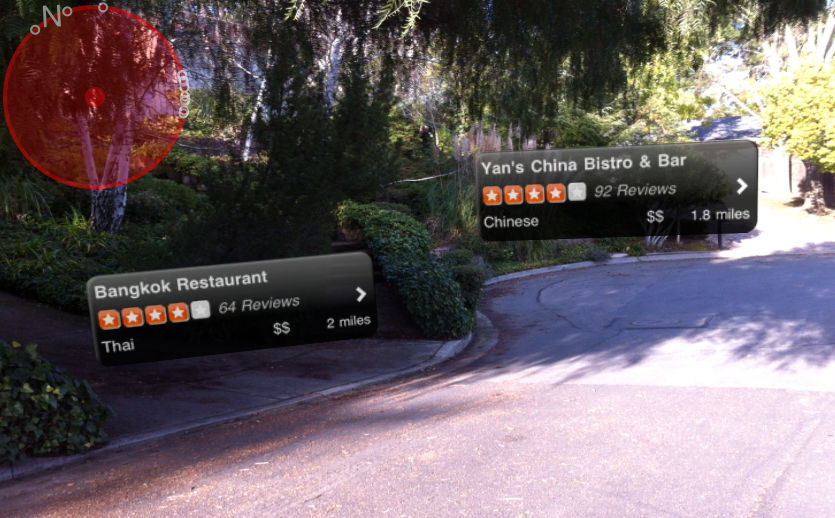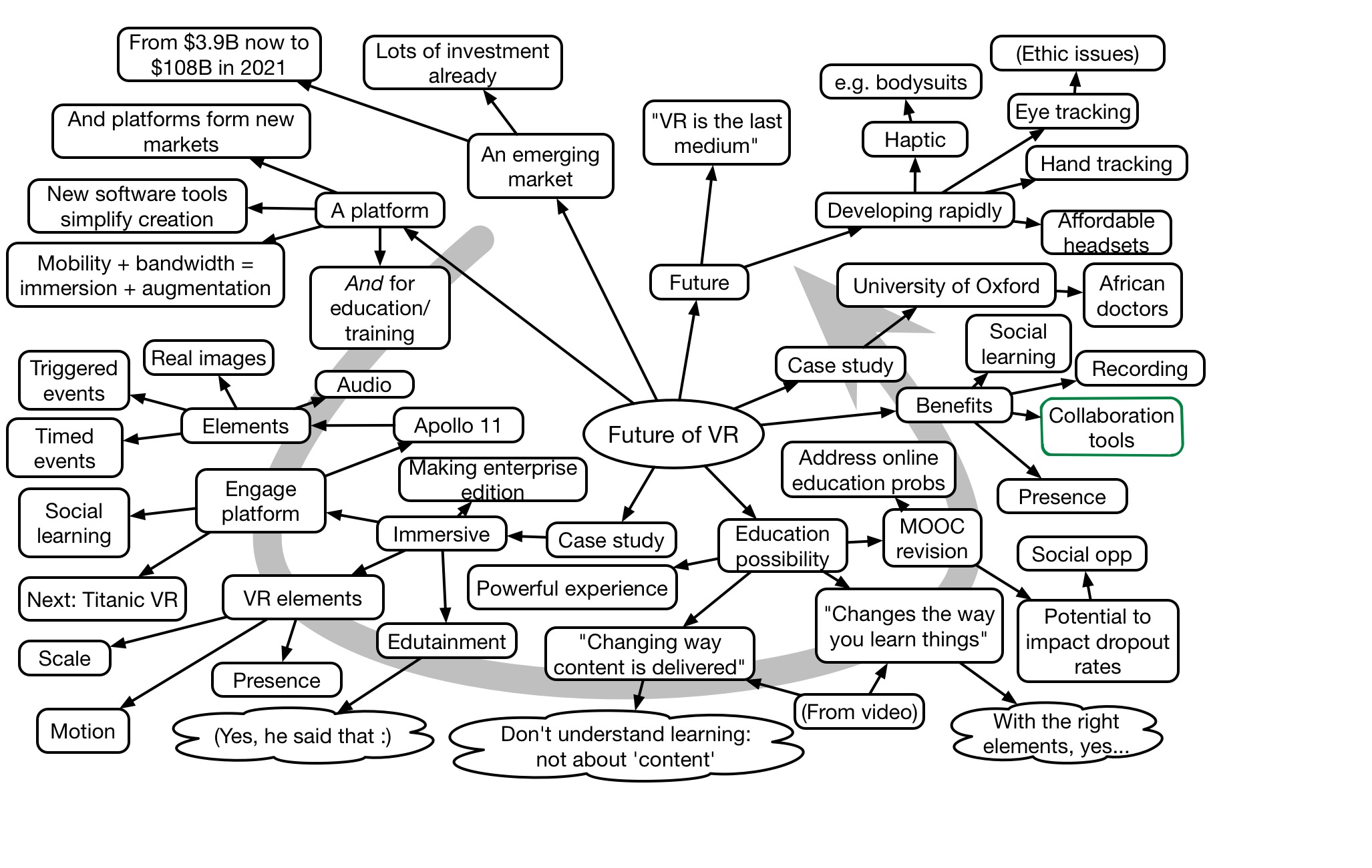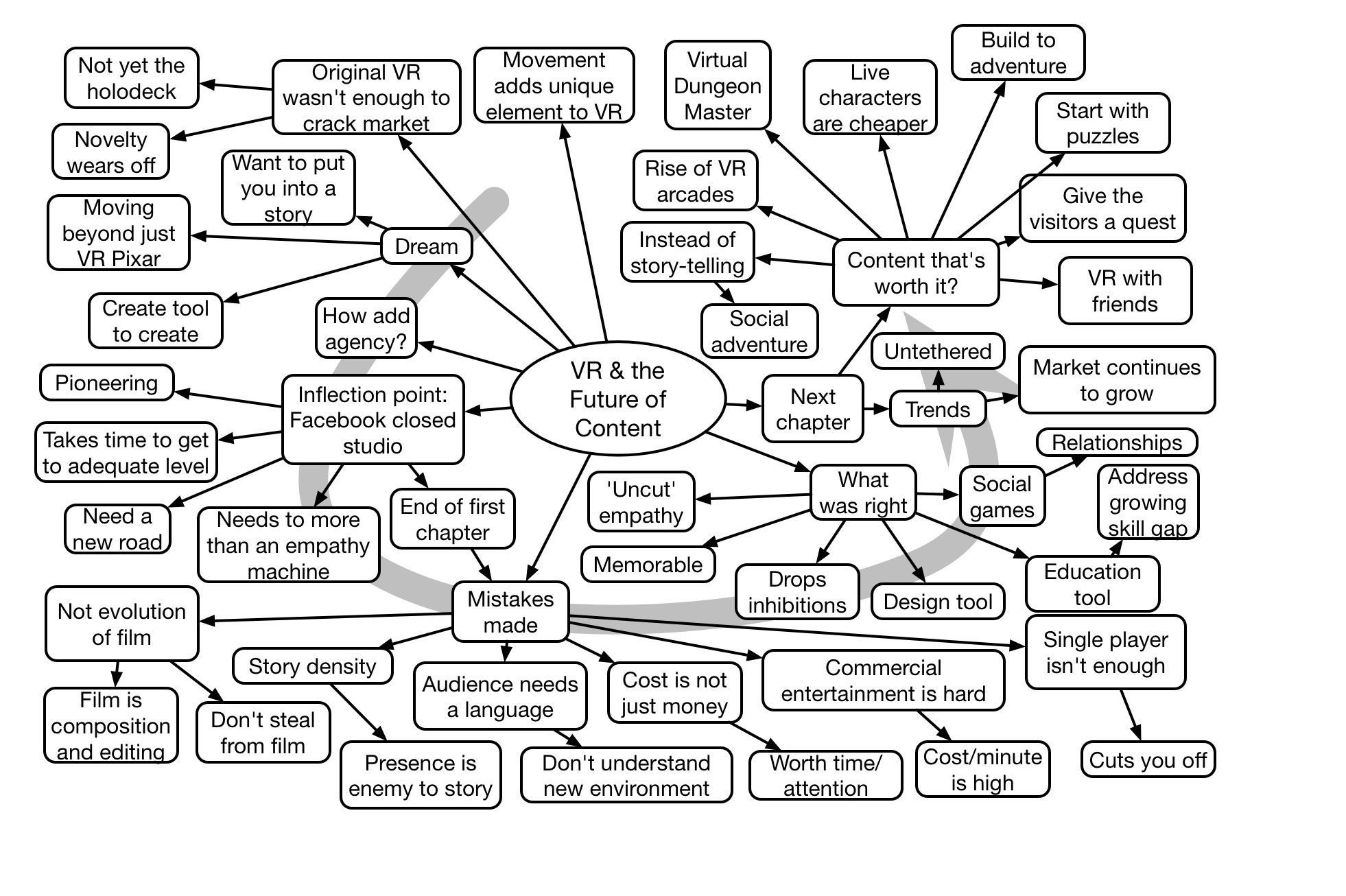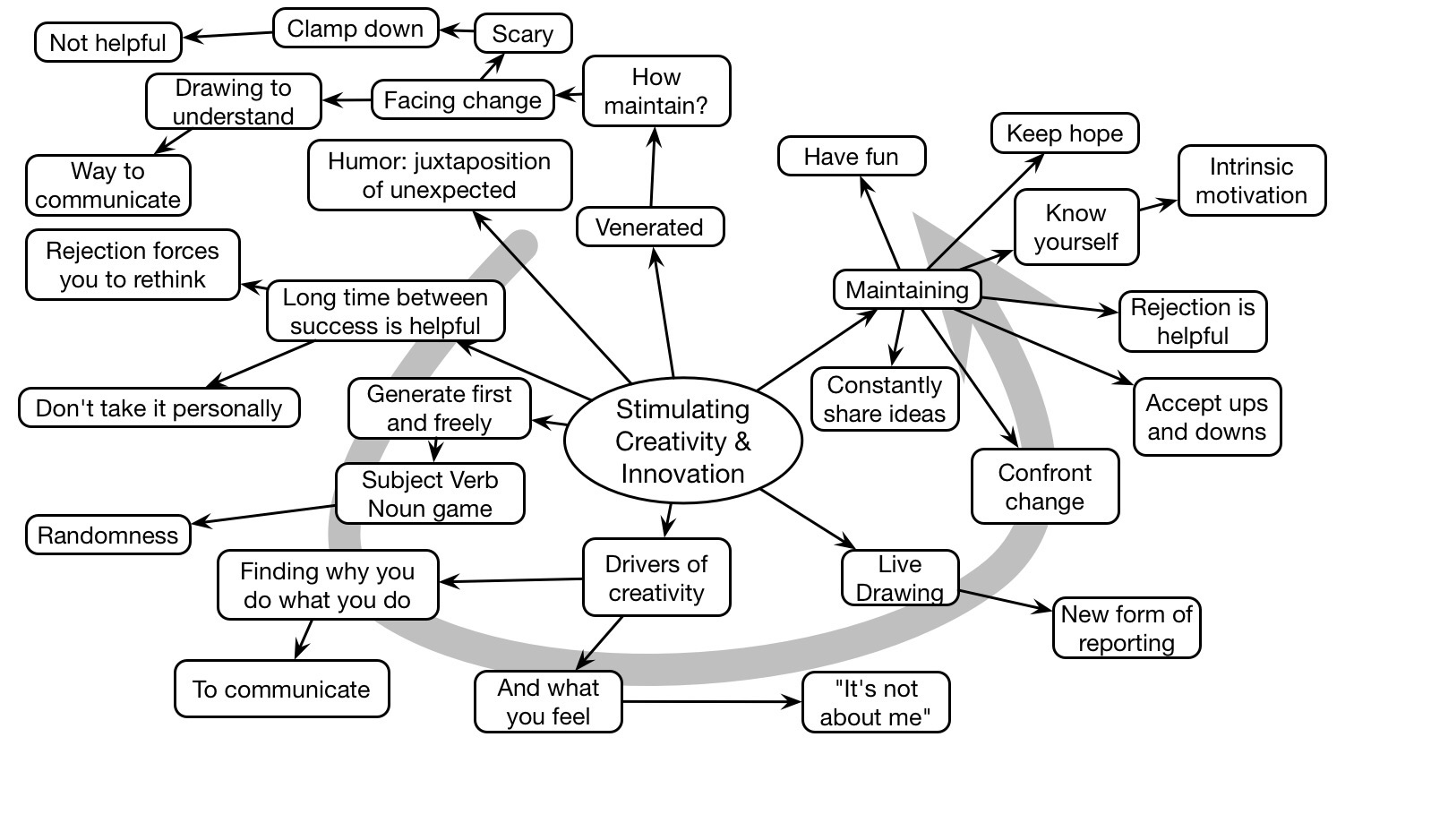Barry Downes talked about the future of the VR market with an interesting exploration of the Immersive platform. Taking us through the Apollo 11 product, he showed what went into it and the emotional impact. He showed a video that talked (somewhat simplistically) about how VR environments could be used for learning. (There is great potential, but it’s not about content.). He finished with an interesting quote about how VR would be able to incorporate any further media. A second part of the quote said: “Kids will think it’s funny [we] used to stare at glowing rectangles hoping to suspend disbelief.”
Maxwell Planck #Realities360 Keynote Mindmap
Maxwell Planck opened the eLearning Guild’s Realities 360 conference with a thoughtful and thought-provoking talk on VR. Reflecting on his experience in the industry, he described the transition from story telling to where he thinks we should go: social adventure. (I want to call it “adventure together”. :). A nice start to the event.
Augmented Reality Lives!
 Augmented Reality (AR) is on the upswing, and I think this is a good thing. I think AR makes sense, and it’s nice to see both solid tool support and real use cases emerging. Here’s the news, but first, a brief overview of why I like AR.
Augmented Reality (AR) is on the upswing, and I think this is a good thing. I think AR makes sense, and it’s nice to see both solid tool support and real use cases emerging. Here’s the news, but first, a brief overview of why I like AR.
As I’ve noted before, our brains are powerful, but flawed. As with any architecture, any one choice will end up with tradeoffs. And we’ve traded off detail for pattern-matching. And, technology is the opposite: it’s hard to get technology to do pattern matching, but it’s really good at rote. Together, they’re even more powerful. The goal is to most appropriately augment our intellect with technology to create a symbiosis where the whole is greater than the sum of the parts.
Which is why I like AR: it’s about annotating the world with information, which augments it to our benefit. It’s contextual, that is, doing things because of when and where we are. AR augments sensorily, either auditory or visual (or kinesthetic, e.g. vibration). Auditory and kinesthetic annotation is relatively easy; devices generate sounds or vibrations (think GPS: “turn left here”). Non-coordinated visual information, information that’s not overlaid visually, is presented as either graphics or text (think Yelp: maps and distances to nearby options). Tools already exist to do this, e.g. ARIS. However, arguably the most compelling and interesting is the aligned visuals.
Google Glass was a really interesting experiment, and it’s back. The devices – glasses with camera and projector that can present information on the glass – were available, but didn’t do much because of where you were looking. There were generic heads-up displays and camera, but little alignment between what was seen and what was consequently presented to the user with additional information. That’s changed. Google Glass has a new Enterprise Edition, and it’s being used to meet real needs and generate real outcomes. Glasses are supporting accurate placement in manufacturing situations requiring careful placement. The necessary components and steps are being highlighted on screen, and reducing errors and speeding up outcomes.
And Apple has released it’s Augmented Reality software toolkit, ARKit, with features to make AR easy. One interesting aspect is built-in machine learning, which could make aligning with objects in the world easy! Incompatible platforms and standards impede progress, but with Google and Apple creating tools for each of their platforms, development can be accelerated. (I hope to find out more at the eLearning Guild’s Realities 360 conference.)
While I think Virtual Reality (VR) has an important role to play for deep learning, I think contextual support can be a great support for extending learning (particularly personalization), as well as performance support. That’s why I’m excited about AR. My vision has been that we’ll have a personal coaching system that will know where and when we are and what our goals are, and be able to facilitate our learning and success. Tools like these will make it easier than ever.
A Bad Tart
Good learning requires a basis for intrinsic interest. The topic should be of interest to the learner, a priori or after the introduction. If the learner doesn’t ‘get’ why this learning is relevant to them, it doesn’t stick as well. And this isn’t what gamification does. So tarting up content is counter-productive. It’s a bad (s)tart!
Ok, to be clear, there’re two types of gamification. The first, important, and relevant type of gamification is using game design techniques to embed learning topic into meaningful series of decisions, where the context and actions taken affect the outcomes in important ways, and the challenge is appropriate. However, that’s not the one that’s getting all the hype.
Instead, the hype is around PBL (which, sadly isn’t Problem-Based Learning but instead is Points, Badges, & Leaderboards). If we wrap this stuff around our learning, we’ll make it more engaging. And, at least initially, we’ll see that. At least in enthusiasm. But how about retention and transfer? And will there be a drop-off when the novelty wears off?
Yes, we can tart up drill-and-kill, and should, if that’s what’s called for (e.g. accurate retention of information). But that’s not what works for skills. And the times it’s actually relevant are scarce. For skills, we want appropriate retrieval. And that means something else.
Retention and transfer of new skills requires contextualized retrieval and application to decisions that learners need to be able to make. And that’s scenarios (or, at least, mini-scenarios). We need to put learners into situations requiring applying the knowledge to make decisions. Then the consequences play out.
If you’re putting your energy into finding gratuitous themes to wrap around knowledge recitation instead of making intrinsically meaningful contexts for knowledge application, you’re wasting time and money. You’re not going to develop skills.
I actually don’t mind if you want to tart up after you’ve done the work of making the skill practice meaningful. But only after! If you’re skipping the important practice design, you’re letting down your learners. As well as the organization. And typically we don’t need to spend unnecessary time.
Please, for your learners’ sake, find out about both sorts of gamification, distinguish between them, and then use them appropriately. PBL is ok when rote knowledge has to be drilled, or after you’ve done good practice design.
Writing For Learning: Patti Shank book
While I ordinarily refuse (on principle, otherwise I’d get swamped and become a PR hack; and I never promise a good review), I acquiesced to Patti Shank’s offer of a copy of her new book Write and Organize for Deeper Learning. I’ve been a fan of her crusade for science in learning (along with others like Will Thalheimer, Julie Dirksen, and Michael Allen, to name a few co-conspirators on the Serious eLearning Manifesto), and I can say I’m glad she offered and delivered. This is a contribution to the field, with a focus on writing.
The first of a potential series on evidence-based processes in learning design, this one is focused on content: writing and organization. In four overall strategies with 28 total tactics, she takes you through what you should do and why. Practicing what she preaches, and using the book itself recursively as an example, she uses simple words and trimmed down prose to focus on what you need to know, and guidance to generalize it. She also has practice exercises to help make the material stick.
Which isn’t to say there aren’t quibbles: for one, there’s no index! I wanted to look for ‘misconceptions’ (an acid test in my mind), but it’s in there. Still, there’s less on cognitive models to guide performance than I would like. And not enough on misconceptions, But there’re lots of good tips that I wouldn’t have thought of including, and are valuable.
These are small asides. Some of it’s generic (writing for the web, for instance, similarly argues for whitespace) and some specific to learning, but it’s all good advice, and insufficiently seen. What’s there will certainly improve the quality of your learning design. If you write prose for elearning, you definitely should read, and heed, this book. I note, by the way, that my readability index for this blog always falls too high according to her standards ;).
She has a list of other potential books, and I can hope that she will at least deliver the one on designing practice and feedback (what I think is the biggest opportunity to improve elearning: what people do), but also examples, job aids, evaluating, objectives, and more. I hope this series continues to develop, based upon the initial delivery here.
An objective request
 So, I’d like to ask a favor of you. I would like to improve my thinking about elearning design, and where this starts are objectives. Or outcomes. Now, they can be easy, or challenging. I’d like to see some of the latter.
So, I’d like to ask a favor of you. I would like to improve my thinking about elearning design, and where this starts are objectives. Or outcomes. Now, they can be easy, or challenging. I’d like to see some of the latter.
When the goal is fairly obvious, it’s simple to address. They need to be better at doing X? Well then, practice lots of X! But there are more challenging situations. You know the ones: weak verbs that aren’t about doing, where the performance is vague, where it’s about knowledge.
I’d like to get concrete. So…
I’d greatly appreciate it if you would share your challenging learning objectives (or outcomes you’re supposed to come up with objectives for) with me. The ones you dread. If they’re proprietary, feel free to generify them. I will also keep you anonymous. Feel free to ask for help, and I’ll respond appropriately.
What will I do with them? It depends. These may get written up as a post, if I see themes. They certainly are likely to be included in any workshops about deeper elearning design. I just want to work from real things, not my made up examples (as fabulous as they might be ;).
Feel free to comment here, or if you see this via LinkedIn or some other channel respond in whatever channel makes the most sense. Let me know if you’d like a reply.
And thanks in advance.
FocusOn Learning reflections
If you follow this blog (and you should :), it was pretty obvious that I was at the FocusOn Learning conference in San Diego last week (previous 2 posts were mindmaps of the keynotes). And it was fun as always. Here are my reflections on what happened a bit more, as an exercise in meta-learning.
There were three themes to the conference: mobile, games, and video. I’m pretty active in the first two (two books on the former, one on the latter), and the last is related to things I care and talk about. The focus led to some interesting outcomes: some folks were very interested in just one of the topics, while others were looking a bit more broadly. Whether that’s good or not depends on your perspective, I guess.
Mobile was present, happily, and continues to evolve. People are still talking about courses on a phone, but more folks were talking about extending the learning. Some of it was pretty dumb – just content or flash cards as learning augmentation – but there were interesting applications. Importantly, there was a growing awareness about performance support as a sensible approach. It’s nice to see the field mature.
For games, there were positive and negative signs. The good news is that games are being more fully understood in terms of their role in learning, e.g. deep practice. The bad news is that there’s still a lot of interest in gamification without a concomitant awareness of the important distinctions. Tarting up drill-and-kill with PBL (points, badges, and leaderboards; the new acronym apparently) isn’t worth significant interest! We know how to drill things that must be, but our focus should be on intrinsic interest.
As a side note, the demise of Flash has left us without a good game development environment. Flash is both a development environment and a delivery platform. As a development environment Flash had a low learning threshold, and yet could be used to build complex games. As a delivery platform, however, it’s woefully insecure (so much so that it’s been proscribed in most browsers). The fact that Adobe couldn’t be bothered to generate acceptable HTML5 out of the development environment, and let it languish, leaves the market open for another accessible tool. And Unity or Unreal provide good support (as I understand it), but still require coding. So we’re not at an easily accessible place. Oh, for HyperCard!
Most of the video interest was either in technical issues (how to get quality and/or on the cheap), but a lot of interest was also in interactive video. I think branching video is a real powerful learning environment for contextualized decision making. As a consequence the advent of tools that make it easier is to be lauded. An interesting session with the wise Joe Ganci (@elearningjoe) and a GoAnimate guy talked about when to use video versus animation, which largely seemed to reflect my view (confirmation bias ;) that it’s about whether you want more context (video) or concept (animation). Of course, it was also about the cost of production and the need for fidelity (video more than animation in both cases).
There was a lot of interest in VR, which crossed over between video and games. Which is interesting because it’s not inherently tied to games or video! In short, it’s a delivery technology. You can do branching scenarios, full game engine delivery, or just video in VR. The visuals can be generated as video or from digital models. There was some awareness, e.g. fun was made of the idea of presenting powerpoint in VR (just like 2nd Life ;).
I did an ecosystem presentation that contextualized all three (video, games, mobile) in the bigger picture, and also drew upon their cognitive and then L&D roles. I also deconstructed the game Fluxx (a really fun game with an interesting ‘twist’). Overall, it was a good conference (and nice to be in San Diego, one of my ‘homes’).
Nathalie Nahai #FocusOnLearn Keynote Mindmap
Nathalie Nahai opened the second day of the FocuOn Learning conference. In a rapid fire presentation, she covered 7 principles that engage individuals into behaviors. With clear examples from familiar online experiences, she portrayed how these things work. Admirably, she finished with a call to ethical behavior.
Liza Donnelly #FocusOnLearn Keynote Mindmap
Liza Donnelly opened the FocusOn Learn conference with stories from her career as a cartoonist. With a very personal and compelling story illustrated by her cartoons and some live drawing, she unpacked creativity and innovation. With lessons about commitment and meaning, it was a really nice kickoff to the event.
Tech and School Problems
After yesterday’s rant about problems in local schools, I was presented with a recent New York Times article. In it, they talked about how the tech industry was getting involved in schools. And while the initiatives seem largely well-intentioned, they’re off target. There’s a lack of awareness of what meaningful learning is, and what meaningful outcomes could and should be. And so it’s time to shed a little clarity.
Tech in schools is nothing new, from the early days of Apple and Microsoft vying to provide school computers and getting a leg up on learners’ future tech choices. Now, however, the big providers have even more relative leverage. School funds continue to be cut, and the size of the tech companies has grown relative to society. So there’s a lot of potential leverage.
One of the claims in the article is that the tech companies are able to do what they want, and this is a concern. They can dangle dollars and technology as bait and get approval to do some interesting and challenging things.
However, some of the approaches have issues beyond the political:
One approach is to teach computer science to every student. The question is: is this worth it? Understanding what computers do well (and easily), and perhaps more importantly what they don’t, is necessary, no argument. The argument for computer programming is that it teaches you to break down problems and design solutions. But is computer science necessary? Could it be done with, say, design thinking? Again, all for helping learners acquire good problem-solving skills. But I’m not convinced that this is necessarily a good idea (as beneficial as it is to the tech industry ;).
Another initiative is using algorithms, rules like the ones that Facebook uses to choose what ads to show you, to sequence math. A program, ALEKS, already did this, but this one mixes in gamification. And I think it’s patching a bad solution. For one, it appears to be using the existing curriculum, which is broken (too much rote abilities, too little transferable skills). And gamification? Can’t we, please, try to make math intrinsically interesting by making it useful? Abstract problems don’t help. Drilling key skills is good, but there are nuances in the details.
A second approach has students choosing the problems they work on, and teachers being facilitators. Of course, I’m a fan of this; I’ve advocated for gradually handing off control of learning to learners, to facilitate their development of self-learning. And in a recently-misrepresented announcement, Finland is moving to topics with interleaved skills rapped around them (e.g. not one curricula, but you might intersect math and chemistry in studying ecosystems. However, this takes teachers with skills across both domains, and the ability to facilitate discussion around projects. That’s a big ask, and has been a barrier to many worthwhile initiatives. Compounding this is that the end of a unit is assessed by a 10-point multiple choice question. I worry about the design of those assessments.
I’m all for school reform. As Mark Warschauer put it, the only things wrong with American education is the curriculum, the pedagogy, and the way we use technology. I think the pedagogy being funded in the latter description is a good approach, but there are details that need to be worked out to make it a scalable success. And while problem-solving is a good curricular goal, we need to be thoughtful about how we build it in. Further, motivation is an important component about learning, but intrinsic or extrinsic?
We really could stand to have a deeper debate about learning and how technology can facilitate it. The question is: how do we make that happen?



